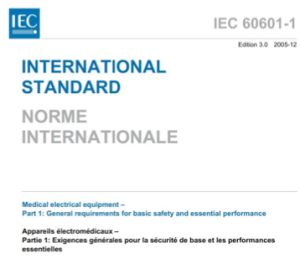Avoiding Clinical Evaluation Report (CER) Pitfalls
This article explains the key steps to preparing a successful clinical evaluation report (CER) for the submission of a technical file for medical device CE Marking.

Essential requirement 6a, the clinical evaluation report (CER), is required for all medical devices that are CE Marked. Up until the Medical Device Directive (MDD) was modified in 2010 (i.e., 2007/47/EC), only high-risk devices required a clinical evaluation report. After the MDD was changed, a CER was needed for all medical devices–even Class I devices that do not require a Notified Body. To help manufacturers understand the expectations and comply with this requirement, a guidance document was released for clinical evaluations in December of 2009 (i..e., MEDDEV 2.7/1 rev 3). MEDDEV 2.7/1 indicates that are there are three options for preparing a clinical evaluation report:
- perform a clinical study and summarize the results,
- perform a literature search of clinical study articles, or
- a combination of the first two options.
Preparing clinical evaluations are tedious but not necessarily challenging. I like to compare the preparation of clinical evaluation reports to bouldering problems. Once someone shows you the most efficient path, climbing the wall no longer seems so challenging.
Literature Search Protocol (TMP-004)
Section 6.1 of the guidance document indicates that a literature search protocol should be used to identify, select, and collate clinical study articles for a literature search. Critical elements of your search protocol should include: which search databases you selected and why, intended use and indications for the use of the device, similar devices that are on the market and a comprehensive date range starting with the earliest clinical studies or the last date of a previous clinical evaluation. Your search protocol should specify inclusion and exclusion criteria, and you will need a systematic method for tracking your results.
I created a protocol template, TMP-004, which I use to perform clinical literature searches. The protocol includes suggested databases for literature sources, a list of adverse event databases, and a database for clinical investigations that should be included in your search. The protocol also includes criteria for evaluating the results of the search. Evaluation criteria should consist of the type of clinical study, the number of patients, the study design, etc.
Qualified Individuals
To conduct a clinical evaluation, you need a cross-functional team–as you should have for all post-market surveillance and risk management activities. One of the team members should be an expert in the design of the device or similar devices. Another person should be an expert in performing literature searches to ensure that the review of the literature is comprehensive. Finally, the team needs at least one person with a clinical research perspective to evaluate the clinical data critically. The qualifications of these individuals should be described in an appendix of your clinical evaluation report, and typically this is done by providing a copy of each person’s resume or curriculum vitae. The omission of these qualifications or the failure to rely upon clinical experts to review the data is a common nonconformity raised by technical reviewers from Notified Bodies.
Selection of Databases
When you are writing a literature search protocol, it is essential to specify why you selected certain search databases and to ensure that you include more than one database. Each literature search database has different strengths and weaknesses. Suppose you are not sure which databases to choose and why this is an indication that you need assistance with the literature search methodology. This is typically part of the process for teaching doctoral candidates how to prepare for writing their dissertation. Therefore academic credentials of the individuals contributing to the post-market surveillance activities are relevant.
Selection of Key Words
Often certain keywords are more common in the title of clinical study articles than others, and these keywords can help narrow the number of literature search results dramatically. Therefore, it is recommended to perform some preliminary searches with different keywords to get a sense of which terms will be the most efficient in helping you to identify the articles that meet your inclusion criteria. These terms can also be used to exclude large numbers of articles that are not relevant. For example, if there are a large number of porcine studies in the literature, you might exclude the term “porcine” to ensure that animal studies involving pigs are excluded from your search results.
Inclusion & Exclusion Criteria
Many times articles will mention a keyword or the name of a device, but the device is only mentioned as an accessory in a study rather than being the focus of the study. If the article only says the device but doesn’t include clinical data regarding its use, then the article should be excluded. Only human studies should be included in your results, and if there are a large number of published studies, you may purposely choose to exclude articles with the terms “case study” that may only include one or two patients.
Addressing Risks
Your clinical evaluation report (CER) is intended to assess the safety of your device by identifying any potential risks that you may have overlooked in your risk analysis and to help you estimate the severity of harm and the probability of occurrence for those harms. It is recommended to perform a preliminary hazard identification and risk analysis before conducting the clinical evaluation to identify the most likely risks associated with the device. Each of these risks should be mentioned explicitly in the clinical evaluation–even if the clinical study data does not identify the risk. If a specific risk is identified during your hazard identification with no clinical data to support the safety of the device related to that risk, then it may be necessary to conduct a clinical study or a post-market clinical follow-up (PMCF) study to evaluate the risk further.
Review of Post-Market Surveillance
When your device is first submitted for CE Marking, you may not have any clinical history with the device, and it is only possible to estimate risks. For this reason, it is important to include post-market surveillance information about similar products as an input to your clinical evaluation process. After your product is launched, you will have a complaint handling data and adverse event data specific to your device. Therefore, you should periodically review the post-market surveillance data and compare it with the initial risk estimates. If the results are similar, then the risk analysis does not need to be updated immediately. If the post-market surveillance results are substantially different from your risk estimates, you should update your clinical evaluation report earlier than planned and update your risk analysis. I recommend stating this conclusion in each report summarizing post-market surveillance data–including a specific recommendation to maintain the current plan for the frequency of conducting clinical evaluations or a recommendation to change the schedule.
Appraisal of Clinical Literature
Your appraisal of clinical literature needs to be systematic and documented. Technical reviewers expect clinical data that supports and detracts from the conclusion that your device is safe and effective for the desired indications. Therefore, you should not exclude articles simply because the findings are negative. You need to include appraisal criteria in your protocol to ensure that the evaluation of literature search results is objective and systematic. I have included a recommended grading system for clinical study articles in my procedure for clinical evaluation reports (i.e., SYS-041). The graded results of each article identified are then summarized in the Appendices of the clinical evaluation report (CER).
Review and Update of Clinical Evaluation Reports (CERs)
Preparing a clinical evaluation report (CER) is time-consuming, but the report is also a living document. Therefore, you need to have a post-market surveillance plan for each medical device or device family that specifies the frequency of performing a review and update of your clinical evaluation report (CER). Depending upon the nature of your device and the amount of clinical history you have with that device, you may also need to conduct a post-market clinical follow-up study (PMCF). Any post-market surveillance that you conduct should be included as an input to the clinical evaluation report. This is why my literature search protocol includes adverse event databases.
Procedures & Templates
If you are looking for a procedure and literature search protocol for preparing a clinical evaluation report (CER), please click here. If you are interested in learning more about post-market surveillance and post-market clinical follow-up (PMCF) studies, we also have a webinar on this topic.
Photos shown in this article are two of my sons, Alex Beshay (13) and Bailey Packard (14), at this weekend’s bouldering competition at PETRA Cliffs in Burlington, VT. Every member of our family is an avid rock climber, including my 3-year-old daughter.
Avoiding Clinical Evaluation Report (CER) Pitfalls Read More »




















